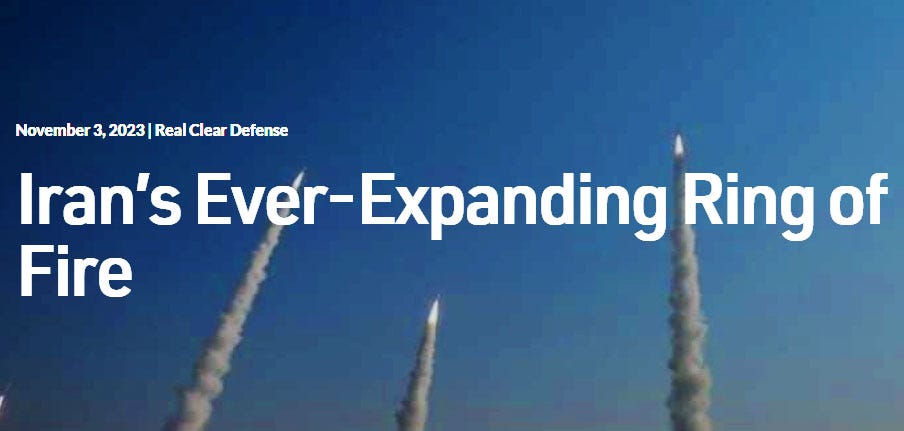Mark Dubowitz & Behnam Ben Taleblu - NOV 3, 2023
Ansar Allah – the helpers of God – as they style themselves, have made good on a years long promise and begun firing missiles and drones at Israel. Their arsenal, which includes land-attack cruise missiles and medium-range ballistic missiles that previously terrorized U.S. partners like Saudi Arabia and the United Arab Emirates is courtesy of one source: The Islamic Republic of Iran.
Iran is home to the largest ballistic missile arsenal in the Middle East. But Tehran’s theocrats have not just been hoarding these systems in a bid to develop a deliverable nuclear weapon. Iran has been refining this arsenal into a more effective battlefield weapon and sharing long-range strike capabilities with proxies it calls the “axis of resistance.”
This slow-motion proliferation has led to Israel’s encirclement with a ring of fire that risks turning any conflict involving the Jewish State into a potential multifront war. Today, Iran is counting on the rocket, drone, and missile arsenal of its proxies to constrain Israel from meaningfully acting against Hamas and Palestinian Islamic Jihad, which are Tehran’s proxies in Gaza. In addition to continuing to traffic weapons, Iran’s Islamic Revolutionary Guard Corps (IRGC) has also supported local production of rockets in places like Gaza since at least 2014.
In Lebanon, Iran has been helping Hezbollah, its oldest and most successful proxy in the Levant, turn its rockets into missiles should the order be given to penetrate and overwhelm Israel’s layered air and missile defenses using precision-guided munitions. Until that day comes, Tehran sees the sheer number of these projectiles as establishing a balance of terror against Jerusalem and preventing kinetic action against Iran’s nuclear facilities.
The successful disbursement of these long-range strike assets coupled with the increasing precision and survivability of Iran’s own missile arsenal has led to a dangerous phenomenon. As Iran’s missile and drone capabilities evolve, barriers to their use are dropping. This means the U.S., Israel, and Saudi Arabia can expect more attacks by both Iran and its proxies.
In September 2019, for example, Iran used a combination of land-attack cruise missiles and suicide drones to target Saudi oil installations. In January 2020, Iran employed a barrage of precision-strike short-range ballistic missiles against U.S. positions in Iraq after the killing of Tehran’s top-terrorist mastermind, Qassem Soleimani, by the Trump administration. The move reportedly marked “the largest ballistic missile attack ever against Americans” and led to over 140 traumatic brain injuries. In January 2021, Iran-backed militants in Iraq fired drones at targets in Saudi Arabia. In July 2021, Iran launched a delta-wing kamikaze drone at an Israeli-owned tanker, killing a British and Romanian national. In January 2022 the Houthis fired medium-range ballistic missiles, drones, and land-attack cruise missiles at the UAE. And in September 2022, Iran fired close-range ballistic missiles and drones at northern Iraq and killed a U.S. citizen. In no instance did the U.S. or its partners respond with force.
Since the October 7 terror attack on Israel and the commensurate bolstering of the U.S. position in the region, U.S. troops have been subject to at least 24 separate rocket or drone attacks, albeit by Iran-backed militias. To date, the Biden administration has only kinetically responded once. On October 26, they launched a “precision self-defense strike” on facilities in Syria linked to the IRGC and Iran-backed militias. This followed an attack that resulted in at least 19 traumatic brain injuries and one death due to an ensuing cardiac event. Undeterred, Iran continues to threaten a wider war and it’s militias have already struck back.
The lesson? Restraint by America has not and will not beget restraint by Tehran.
Tehran is also extending the range of its projectiles and is attempting to develop an intercontinental ballistic missile capability under the auspices of a space program. Advances in Iranian space-launch vehicles are what will allow both Europe and the U.S. homeland to come under threat from Iranian nuclear and conventional warhead-carrying missiles in the future.
But shorter-range Iranian projectiles may first reach Europe. With the lapse of UN missile prohibitions, which the Biden administration did nothing to stop, there is no legal barrier preventing Tehran from providing ballistic missiles to Moscow to complement the drones it has thus far given Putin to use against Ukraine.
These developments have rightly moved Europe, for the first time ever, to withhold sanctions relief initially intended for Tehran as required by the 2015 nuclear deal. As promised under that accord, the EU and UK were supposed to delist over 300 entities tied to Iran’s nuclear, missile, and military programs. Europe’s decision to hold the line on sovereign nonproliferation sanctions represents a seriousness not seen from the continent since late 2012 on the Iranian missile threat.
Will Biden use this opportunity to build a new sanctions architecture with U.S. allies to counter Iran’s projectiles, and will he work to restore UN restrictions on them before the ability to do so also lapses in 2025? Those are the easy choices. Harder ones for the administration are how it intends to keep Tehran on the sidelines of the current conflict and help restore deterrence against Iran-backed groups and the ring of fire they intend to ignite against Israel and America. Pinprick strikes simply will not do.
***
Mark Dubowitz is Chief Executive of the Foundation for Defense of Democracies (FDD), where Behnam Ben Taleblu is a senior fellow.
https://www.fdd.org/analysis/2023/11/03/irans-ever-expanding-ring-of-fire/






